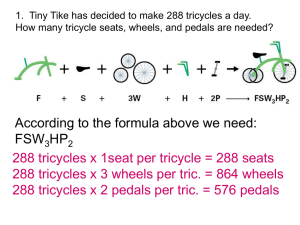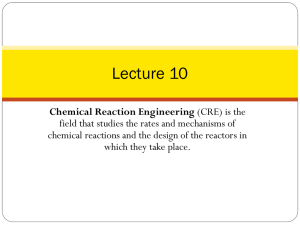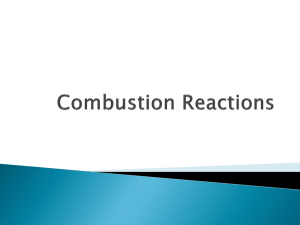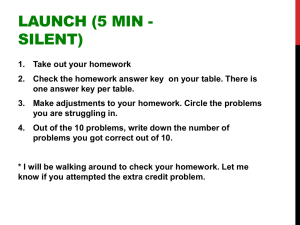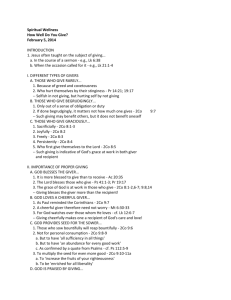File
advertisement
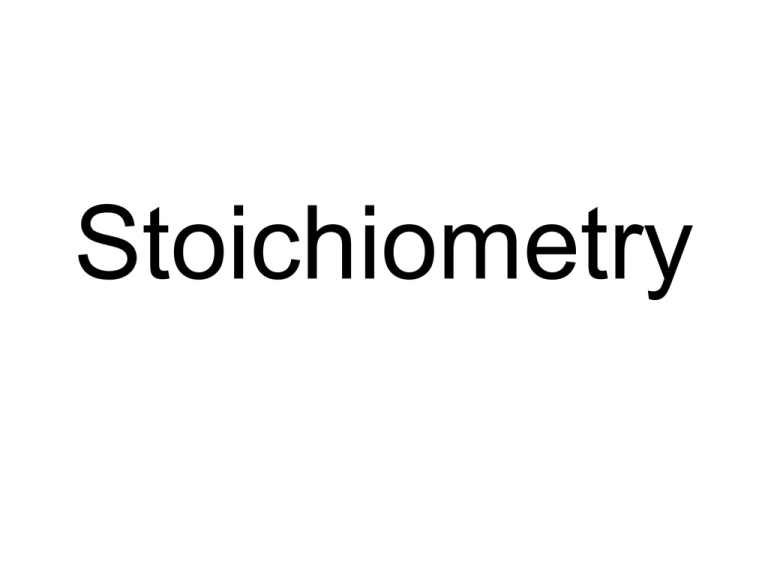
Stoichiometry The Balanced Chemical Reaction A balanced chemical reaction can be interpreted in two ways. First, it can be thought of as describing how many molecules (or atoms or formula units) of reactants are consumed in order to produce a certain number of molecules of products. Analogously, it can be thought of as describing how many moles of reactants are consumed in order to produce the indicated number of moles of products. CuO(s) + H2(g) → Cu(s) + H2O(g) How many H2O molecules are produced for every H2 molecule that is consumed in this reaction? CuO(s) + H2(g) → Cu(s) + H2O(g) How many H2O molecules are produced for every H2 molecule that is consumed in this reaction? 1 2CO(g) + O2(g) → 2CO2(g) How many CO2 molecules are produced for every O2 molecule consumed? 2CO(g) + O2(g) → 2CO2(g) How many CO2 molecules are produced for every O2 molecule consumed? 2 2CO(g) + O2(g) → 2CO2(g) How many CO2 molecules are produced for every CO molecule consumed? 2CO(g) + O2(g) → 2CO2(g) How many CO2 molecules are produced for every CO molecule consumed? 1 2CO(g) + O2(g) → 2CO2(g) How many molecules of CO2 are produced when 2 molecules of O2 are consumed? 2CO(g) + O2(g) → 2CO2(g) How many molecules of CO2 are produced when 2 molecules of O2 are consumed? 4 2CO(g) + O2(g) → 2CO2(g) How many moles of CO2 are produced when 5 moles of O2 are consumed? 2CO(g) + O2(g) → 2CO2(g) How many moles of CO2 are produced when 5 moles of O2 are consumed? 10 CuO(s) + H2(g) → Cu(s) + H2O(g) How many moles of CuO react in order to produce 12 moles of Cu? CuO(s) + H2(g) → Cu(s) + H2O(g) How many moles of CuO react in order to produce 12 moles of Cu? 12 Determine the number of reactant molecules and the number of product molecules for each reaction: CuO(s) + H2(g) → Cu(s) + H2O(g) 2CO(g) + O2(g) → 2CO2(g) Determine the number of reactant molecules and the number of product molecules for each reaction: CuO(s) + H2(g) → Cu(s) + H2O(g) 2 reactant and 2 product 2CO(g) + O2(g) → 2CO2(g) 3 reactant and 2 product Is the number of molecules identical on the reactant and product sides of these balanced reactions? CuO(s) + H2(g) → Cu(s) + H2O(g) 2CO(g) + O2(g) → 2CO2(g) Is the number of molecules identical on the reactant and product sides of these balanced reactions? CuO(s) + H2(g) → Cu(s) + H2O(g) 2CO(g) + O2(g) → 2CO2(g) No Does the total number of moles of gas increase, decrease, or remain constant for this reaction? 2CO(g) + O2(g) → 2CO2(g) Does the total number of moles of gas increase, decrease, or remain constant for this reaction? 2CO(g) + O2(g) → 2CO2(g) Moles decrease. (Moles are not conserved.) No Whiteboard How is this consistent with the idea that atoms are neither created nor destroyed when a chemical reaction takes place? CuO(s) + H2(g) → Cu(s) + H2O(g) Is it correct to state that if 100 grams of CuO are consumed when the reaction occurs, then 100g of Cu are formed in the process? Why or why not? No Whiteboard 2CO(g) + O2(g) → 2CO2(g) Describe in complete sentences the steps taken to calculate the number of grams of CO2 produced in this reaction given that X grams of O2 are consumed. Stoichiometry • Stoichiometry is a quantitative description of a chemical reaction. It involves determining the amounts of reactants and products in a chemical reaction. It is based on the balanced chemical equation. • Stoichiometry answers “How much?” Mole Ratio • A mole ratio is a conversion factor used in stoichiometry. It is the ratio of moles of one reactant or product to another reactant or product based on the coefficients of a balanced chemical equation. It allows you to convert moles of one substance to moles of another substance in a chemical reaction. 2CO(g) + O2(g) → 2CO2(g) 4 moles of O2 will react to form how many moles of CO2 according to the above chemical equation? 4 mol O2 x 2 mol CO2 = 8 mol CO2 1 mol O2 Mole Ratio! Practice Al + CuSO4 → Al2(SO4)3 + Cu Practice 2Al + 3CuSO4 → Al2(SO4)3 + 3Cu Remember! You must always use a balanced chemical equation for all stoichiometry problems.



